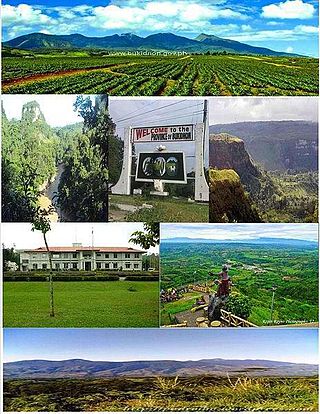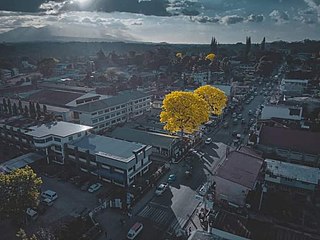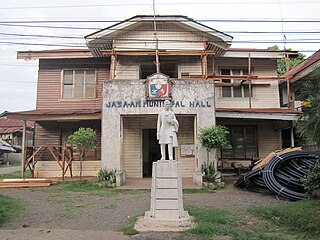
Bukidnon, officially the Province of Bukidnon, is a landlocked province in the Philippines located in the Northern Mindanao region. Its capital is the city of Malaybalay. The province borders, clockwise from the north, Misamis Oriental, Agusan del Sur, Davao del Norte, Cotabato, Lanao del Sur, and Lanao del Norte. According to the 2020 census, the province is inhabited by 1,541,308 residents. The province is composed of 2 component cities and 20 municipalities. It is the third largest province in the country in terms of total area of jurisdiction behind Palawan and Isabela respectively.

Malaybalay, officially the City of Malaybalay, is a 1st class component city and capital of the province of Bukidnon, Philippines. According to the 2020 census, it has a population of 190,712 people.

Lantapan, officially the Municipality of Lantapan, is a 1st class municipality in the province of Bukidnon, Philippines. According to the 2020 census, it has a population of 65,974 people.

Tagoloan, officially the Municipality of Tagoloan and also known as Tagoloan II, is a 4th class municipality in the province of Lanao del Sur, Philippines. According to the 2020 census, it has a population of 12,602 people. It is the poorest municipality in the whole country of the Philippines.

Cabanglasan, officially the Municipality of Cabanglasan, is a 3rd class municipality in the province of Bukidnon, Philippines. According to the 2020 census, it has a population of 36,286 people.

Damulog, officially the Municipality of Damulog, is a 4th class municipality in the province of Bukidnon, Philippines. According to the 2020 census, it has a population of 39,322 people.

Dangcagan, officially the Municipality of Dangcagan, is a 3rd class municipality in the province of Bukidnon, Philippines. According to the 2020 census, it has a population of 26,076 people.

Don Carlos, officially the Municipality of Don Carlos, is a 1st class municipality in the province of Bukidnon, Philippines. According to the 2020 census, it has a population of 69,273 people.

Impasugong, officially the Municipality of Impasugong, is a 1st class municipality in the province of Bukidnon, Philippines. According to the 2020 census, it has a population of 53,863 people.

Kibawe, officially the Municipality of Kibawe, is a 2nd class municipality in the province of Bukidnon, Philippines. According to the 2020 census, it has a population of 41,897 people.

Malitbog, officially the Municipality of Malitbog, is a 2nd class municipality in the province of Bukidnon, Philippines. According to the 2020 census, it has a population of 26,741 people.

Manolo Fortich, officially the Municipality of Manolo Fortich, is a 1st class municipality in the province of Bukidnon, Philippines. According to the 2020 census, it has a population of 113,200 people.

Pangantucan, officially the Municipality of Pangantucan, is a 1st class municipality in the province of Bukidnon, Philippines. According to the 2020 census, it has a population of 56,580 people.

Quezon, officially the Municipality of Quezon, is a 1st class municipality in the province of Bukidnon, Philippines. According to the 2020 census, it has a population of 109,624 people.

San Fernando, officially the Municipality of San Fernando, is a 1st class municipality in the province of Bukidnon, Philippines. According to the 2020 census, it has a population of 63,045 people.

Sumilao, officially the Municipality of Sumilao, is a 4th class municipality in the province of Bukidnon, Philippines. According to the 2020 census, it has a population of 29,531 people.

Talakag, officially the Municipality of Talakag, is a 1st class municipality in the province of Bukidnon, Philippines. According to the 2020 census, it has a population of 77,027 people.

Alubijid, officially the Municipality of Alubijid, is a 4th class municipality in the province of Misamis Oriental, Philippines. According to the 2020 census, it has a population of 32,163 people.

Jasaan, officially the Municipality of Jasaan, is a 2nd class municipality in the province of Misamis Oriental, Philippines. According to the 2020 census, it has a population of 57,055 people.

Villanueva, officially the Municipality of Villanueva, is a 2nd class municipality in the province of Misamis Oriental, Philippines. According to the 2020 census, it has a population of 40,419 people.
























